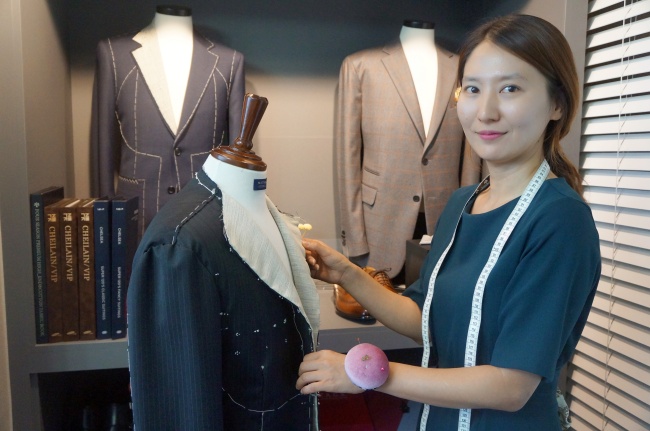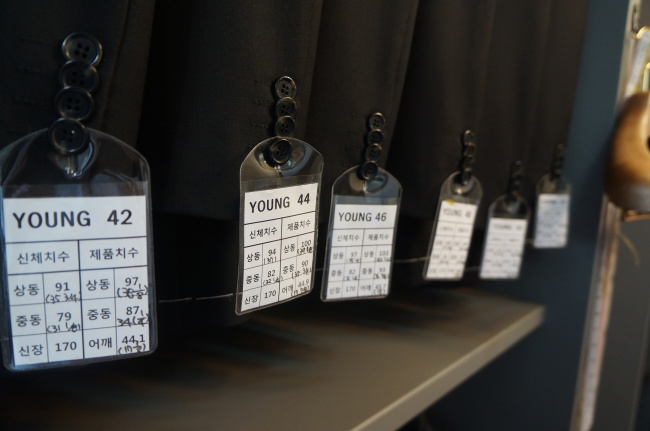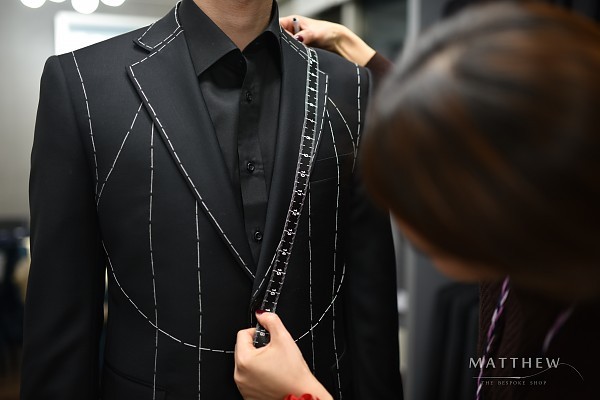Walking into a tailor shop, one imagines being greeted by a stylish, well-manicured man. He sports a classic yet chic beard and is dressed in an expensive-looking bespoke suit, complete with lapel pins, cufflinks and a silk pocket square.
Stepping into Matthew in Bundang, Gyeonggi Province, a 30-minute drive southeast of Seoul, a different picture unfolds. A tall woman in her 30s walks up to you with a big smile, donning a long dress.
She introduces herself: Kang Ae-wan, master tailor of the shop.
 |
Tailor Kang Ae-wan poses for photos before an interview with The Korea Herald at her tailor shop Matthew, in Bundang, southeast of Seoul. (Im Eun-byel/The Korea Herald) |
While it is not easy to find a female tailor who runs her own shop, Kang has been an owner-tailor for over a year. Though she does not give much thought to her gender, there are some advantages to being a woman in the profession.
“I do not actually wear a male suit,” Kang told The Korea Herald during an interview at her shop. “As a result, my perspective is objective. Some male tailors are prejudiced, actually wearing the suits they make. But what they think cannot be applied to everyone.”
 |
Tags that include customers’ body size information hang on tailored jackets. (Im Eun-byel/The Korea Herald) |
Kang got started in the clothing industry around 10 years ago, working for an online retailer. She was met with skepticism, having studied law in college. With zero experience in the fashion industry, she started her career by dealing with customers.
“I really did not have too many thoughts at the time. I just liked clothes,” she said. But she believed in the power of working step by step.
Kang moved on to merchandising, then to styling. The next step for her was working at a company that specializes in men’s bespoke suit. She started with measuring the clients.
“Men’s suits were more attractive, as it was a field that required study, and it suited me more as I am someone who studies,” she recounted.
As she took classes at private institutions and learned the basics, people at work helped her out, recognizing her passion. She learned pattern-making and cutting there.
After taking some time off due to health reasons, she opened a tailoring house, as at that point it was what she had done for 10 years.
Of course, some were unsure of Kang, as a woman in the profession. She could see the distrust in their eyes.
“I have measured more than 7,000 customers. I can see what they are thinking by just looking at their faces. Some leave after consulting, because they don’t trust me. But still, most try to trust me,” she said.
“There was this customer recently, a man in his 50s. When everything was finished, he told me, ‘I was unsure at first because you are a woman. But now I realize that you are very skilled. I am waiting for the suit with great expectations.’”
 |
Kang measures the length of a jacket lapel. (Matthew) |
As a tailor, Kang believes that everyone should be able to wear a bespoke suit, especially as more people have “unbalanced” figures. Many people find it hard to fit into ready-made suits.
“Everyone should have the right to wear bespoke suits. Office workers call their suits a combat gear, as it is the clothing they don for making a living,” she said. “Some male tailors think that only high-end bespoke suits should be made. If that were the case, not many could afford to wear bespoke suits.”
Reflective of her values, Kang’s suits come in a wide price range. The cheaper ones are priced at 350,000 won ($314). Midrange suits sit at around 500,000 won and those that use imported Italian fabrics are priced at 1 million won.
“In the past, people used to wear hand-me-down suits. At the time, expensive suits may have been practical,” Kang said. “But now is the era of fast fashion. Even five years is a long time to wear a suit.”
At Kang’s shop, the client and Kang talk about why the person needs a suit and what kind of a suit he is considering. She also asks the client about his lifestyle and what kind of suits he already owns.
Speaking of measurement, she stressed the importance of “emotional size.”
“Everyone comes to have a custom-tailored suit made so they can wear the right sized one. But ‘right size’ means different things from person to person. Some like their suits tight, others like it loose. It is important to catch what they are thinking,” she said.
Choosing the fabric, getting the measurements done, a client must visit the shop three times and wait for a month for the fully tailored suit. Kang hopes for more understanding about the process.
“There are customers who call and say, ‘I need a suit for the day after tomorrow’ or ‘Can I have a suit in five days?’ But a tailored suit is not something that comes out in a day. I can understand what a client wants only by spending more time with him.”
She also hopes suits can connote a different meaning.
“In Korea, there is a sense of coerciveness associated with suits. It is worn because you have to wear it. So there are negative implications to suits and that’s why the business has been struggling in general,” Kang said.
“I am trying to make lighter ones -- lighter in fabric, in design. If I carry on such efforts, more people may willingly wear suits, simply because they want to. Hopefully, more people can be comfortable wearing tailored suits.”
By Im Eun-byel (
silverstar@heraldcorp.com)










![[Weekender] Korea's traditional sauce culture gains global recognition](http://res.heraldm.com/phpwas/restmb_idxmake.php?idx=644&simg=/content/image/2024/11/21/20241121050153_0.jpg)